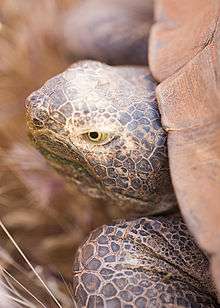Leopard tortoise
| Leopard tortoise | |
|---|---|
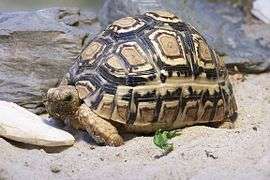 | |
| Scientific classification | |
| Kingdom: | Animalia |
| Phylum: | Chordate |
| Class: | Sauropsida |
| Order: | Testudines |
| Suborder: | Cryptodira |
| Family: | Testudinidae |
| Genus: | Stigmochelys Gray, 1873 |
| Species: | S. pardalis |
| Binomial name | |
| Stigmochelys pardalis[1][2] (Bell, 1828) | |
| Synonyms[3] | |
| |
The Leopard tortoise (Stigmochelys pardalis) is a large and attractively marked tortoise found in the savannas of Eastern and Southern Africa, from Sudan to the southern Cape. It is the only member of the genus Stigmochelys, but in the past it was commonly placed in Geochelone instead.[1] This chelonian is a grazing species of tortoise that favors semi-arid, thorny to grassland habitats, although some leopard tortoises have been found in rainier areas. In both very hot and very cold weather they may dwell in abandoned fox, jackal, or anteater holes. Leopard tortoises do not dig other than to make nests in which to lay eggs. Not surprisingly, given its propensity for grassland habitats, it grazes extensively upon mixed grasses. It also favors succulents and thistles, and (in captivity) the fruit and pads of the prickly pear cactus (Opuntia sp.) (cactus are New World plants not native to Africa). The African Leopard Tortoise typically lives 80 to 100 years.
Taxonomy and etymology
Its generic name is a combination of two Greek words:Stigma meaning "mark" or "point"* and Chelone(Χελωνη) meaning "tortoise". Its specific name pardalis is from the Latin word pardus meaning "leopard" and refers to the leopard-likespots on the tortoise's shell.
Description
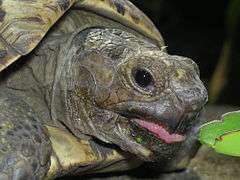
The leopard tortoise is the fourth largest species of tortoise in the world, with typical adults reaching 18-inch (460 mm) and weighing 40-pound (18 kg).[4] Large examples may be 70-centimetre (28 in) long and weigh up to 120-pound (54 kg).[5] An adult's maximum shell length can reach a 24-inch (610 mm) diameter.[4]
There are regional reports of much larger specimens. Exceptionally the giant Ethiopian form might reach 100-centimetre (39 in). In humid forests in southern Sudan Stigmochelys pardalis may attain lengths of 45 inches.
The carapace is high and domed, sometimes with pyramid shaped scutes. Juveniles and young adults are attractively marked and the markings on each individual are unique. The skin and background colour are cream to yellow, and the carapace is marked with black blotches, spots or even dashes or stripes. However, in mature adults the markings tend to fade to a slaty, nondescript brown or grey, commonly tinged with the local dust.
Behavior
Leopard tortoises are herbivorous. They are more defensive than offensive, retracting feet and head into their shell for protection. This often results in a hissing sound, probably due to the squeezing of air from the lungs as the limbs and head are retracted.
Adaptations
Like most tortoises, they can retract their head and feet into their shell in defense when threatened. Also like all tortoises and turtles, their mouth is a "beak". The rear legs are very trunk-like, the front legs are almost paddle shaped and "pigeon-toed" with a row of small "nails". They can move very fast on these legs, and maneuver over rocky terrain easily. They can also climb and go underwater for up to 10 minutes. Younger animals have a surprising ability to climb, as their toenails provide a very secure grip on wood, concrete, and rough stone surfaces. Small leopard tortoises, under 6 inches (150 mm) in length, have been observed climbing vertically up and over a 12-inch-high (300 mm) wooden board intended to be an enclosure boundary.
Natural history
This is the most widely distributed tortoise in Southern Africa. It has a wide distribution in sub-Saharan Africa, but is absent from all of West Africa and most of Central Africa. It has been recorded in Botswana, Burundi, DR Congo, Ethiopia, Kenya, Malawi, Mozambique, Namibia, Rwanda, Somalia, South Africa, Sudan, Swaziland, Tanzania, Uganda, Zambia and Zimbabwe.[1] Leopard tortoises are the fourth largest species of tortoise, after the African spurred tortoise, the Galapagos tortoise, and Aldabra giant tortoise.
Conservation
Leopard tortoises are increasingly being bred in captivity. This is a positive development, as it should lead to a gradual reduction in demand for animals caught in the wild. In most cases, wild-caught leopard tortoises are not only loaded with ticks, mites and internal parasites, but they are usually very stressed and dehydrated and may not voluntarily eat. Even in the best of circumstances, wild-caught leopard tortoises will run up extensive veterinary bills and much time will be spent rehabilitating them. As of March 22, 2000, the USDA has banned importation of the Leopard tortoise, Bell's hinge-back tortoise and the African spurred tortoise.
In the wild, healthy populations still exist in rural areas, national parks and nature reserves. However, it is a staple food item in the diets of many local peoples. In areas of significant human populations, the leopard tortoise is considered vulnerable.
This tortoise is listed in CITES Appendix II.
Breeding and Reproduction
A very long-lived animal, the leopard tortoise reaches sexual maturity between the ages of 12 and 15 years. Captive leopard tortoises, however, grow faster and may mature as young as 6 years of age.
Leopard tortoises "court" by the male ramming the female. When mating, the male makes grunting vocalizations. After mating, the female lays a clutch consisting of 5 to 18 eggs. The South African leopard tortoise is significantly more difficult to breed in captivity than the common leopard tortoise, S. p. babcocki. Eggs will rarely hatch in an incubator. Most successes have occurred when eggs are left in the ground, and when the climate is similar to the natural one for these tortoises.
As a pet
Leopard tortoises became popular in captivity due to captive breeding. These turtles are very prone to respiratory problems if temperatures are not maintained. Leopard tortoises live at 75–100 °F (24–38 °C). The southern leopard tortoise is more cold tolerant than the northern leopard tortoise.
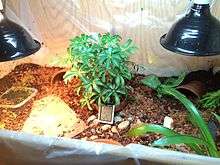
Housing a Pet Leopard Tortoise Indoors
Pet leopard tortoises should mostly live indoors for at least the first six months of life while they are small (vulnerable to predators) and delicate. Adults need a lot of space – at least a 4ftx6ft enclosure. Hatchlings can live in a 2ftx2ft container, such as an underbed storage tub, but they and large aquariums are typically outgrown quickly. The more roaming room, the better, especially if the tortoise is being housed indoors as an adult. Depending on outdoor temperature and safety, tortoises can begin spending an hour or two outside right away, and after around two years they can be moved outside permanently, although bringing them inside at night might be advisable. They are at risk of predation from birds, raccoons, possums, feral animals, birds, and many other creatures, so they need to be a suitable size before being left outside unsupervised. With these risks in mind, outdoor time is the absolute best thing for a tortoise. Nothing is better than natural sunlight and grazing.[6]
Wet Vs. Dry

Recently, there has been debate over how best to raise a pet leopard tortoise for the first six months-one year of its life. The Old School argument is that leopard tortoises are native to arid grasslands and therefore should be raised “dry” on a sandy substrate with low humidity and no available water. This is said to prevent respiratory infections and lower the risk of young tortoises drowning in water dishes. Recent research of wild leopard tortoises reveal that eggs hatch during a rainy season, with almost marshy conditions for the first few months of a tortoise’s life. Furthermore, tortoises spend a great deal of time under plants and partially or totally hidden in underground burrows where humidity is much higher. This is especially true of young tortoises that are still small enough to be vulnerable to predators.
The New School argues for leopard tortoises to be raised “wet”, especially in the first six months, with at least 80% humidity and frequent soaks. This is shown to help prevent “pyramiding” in leopard tortoises. Crucial to this method is a closed enclosure. Humidity and temperature cannot be maintained in a traditional open-top enclosure. With the wet method, temperatures should never drop below 80 °F in order to prevent respiratory infections. The enclosure should include a humid hide such as a terra cotta flower pot slightly buried on its side. The tortoise should be soaked in shallow tepid water (85 °F-95 °F) at least three times a week for at least fifteen minutes each time. The water should be about a third of the way up the body. Hatchlings should be soaked more often and for longer periods, daily soaks of thirty minutes each being ideal. Shallow water dishes, such as terra cotta plant saucers, should be available to the tortoise 24/7. Water should be too shallow to drown in if the tortoise flips, and the dish should be easy to climb in and out of. Live safe plants and daily misting with a water bottle are useful way to maintain humidity.[7]
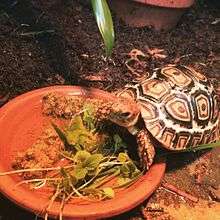
Substrate
The enclosure should have 3-6in of substrate to maintain humidity and provide room for shallow burrowing. Options are: Coco coir, fir bark mulch, cypress much, sphagnum moss, or a mixture of the four.
Lighting and Temperature
A UVA/UVB light is vital for tortoises that do not spend at least two hours outside in the sunlight every week Though not proven, coil style bulbs have sometimes caused to harm tortoise’s eyes and should never be used. There should be a basking spot that is 95 °F-100 °F, and the rest of the habitat should stay at least 75 °F (dry) or 80 °F (wet). An infrared heat emitter is a good option, preferably one that produces no light.[8]
Diet
A wild leopard tortoise mostly eats a variety of grass and scrub, supplemented by succulents and fallen fruit. They meet their high calcium needs by chewing on bones and eating carnivore feces. In captivity, tortoises should be provided with a large variety of grass, weeds, and grocery store greens, in addition to an unbleached cuttlebone (which also helps keep the beak trim). They need greens high in fiber, rich in calcium, high in vitamin A, and with low protein. Grocery store spring mix, collard greens, chard, mustard greens, dandelion greens, endive, escarole, radicchio, bok choy, kale, cactus pads, and other organic dark leafy greens are the best store-bought options. Lettuce, spinach, and succulents may also be fed in moderation as part of a varied diet. Small amounts of squash, zucchini, sweet pepper, and non-citrus fruits can be provided rarely, around once per month, although many experienced breeders recommend against it. A calcium and mineral supplement can be sprinkled on food weekly.[9]
Gallery
 One-month-old hatchling
One-month-old hatchling Small 20-year-old leopard tortoise eating
Small 20-year-old leopard tortoise eating Retracted forelegs of adult female Leopard tortoise
Retracted forelegs of adult female Leopard tortoise
Closeup of scutes 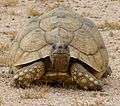 Shell patterns fade in mature specimens
Shell patterns fade in mature specimens Three adult leopard tortoises
Three adult leopard tortoises Leopard tortoise on Azerbaijan stamp
Leopard tortoise on Azerbaijan stamp Three baby leopard tortoises
Three baby leopard tortoises
References
- 1 2 3 Turtles of the World: Annotated Checklist of Taxonomy and Synonymy, December 2010
- ↑ Fritz, U.; Bininda-Emonds, O. R. P. (2007-07-03). "When genes meet nomenclature: Tortoise phylogeny and the shifting generic concepts of Testudo and Geochelone". Zoology. Elsevier. 110 (4): 298–307. doi:10.1016/j.zool.2007.02.003. PMID 17611092.
- ↑ Fritz Uwe; Peter Havaš (2007). "Checklist of Chelonians of the World". Vertebrate Zoology. 57 (2): 294–295. Archived from the original (PDF) on 2010-12-17. Retrieved 29 May 2012.
- 1 2 Branch, Bill (2008). Tortoises, Terrapins & Turtles of Africa. South Africa: Struik Publishers. p. 128. ISBN 1-77007-463-5.
- ↑ Kindersley, Dorling (2001). Animal. New York City: DK Publishing. ISBN 0-7894-7764-5.
- ↑ "Leopard Tortoise Care Sheet". Tortoise Forum. Retrieved 2016-04-11.
- ↑ "How To Raise A Healthy Sulcata Or Leopard, Version 2.0". Tortoise Forum. Retrieved 2016-04-11.
- ↑ Edqvist, ULf. "Tortoise Trust Web - Observations on Dehydration in Reptiles.". www.tortoisetrust.org. Retrieved 2016-04-11.
- ↑ "Geochelone pardalis (Leopard Tortoise) Care – Misty Corton". www.chelonia.org. Retrieved 2016-04-11.
External links
| Wikimedia Commons has media related to Stigmochelys pardalis. |
- Leopard Tortoise, description and picture
- Information about the Leopard Tortoise
- Leopard Tortoise information, pictures and Care information
